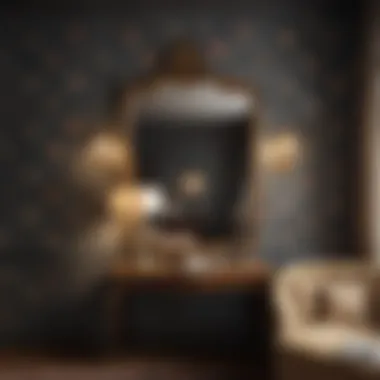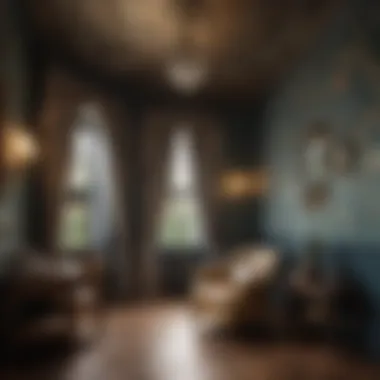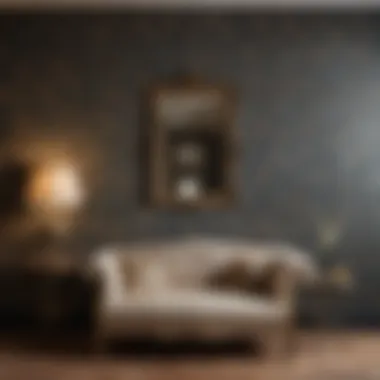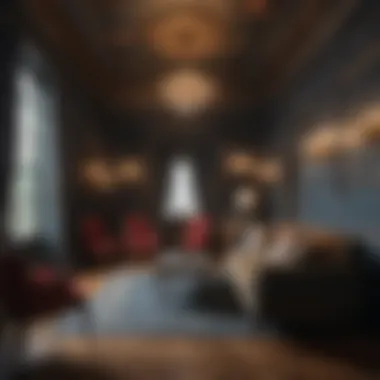The Elegance of 1920 Wallpaper Designs: A Revival of Style


Intro
The wallpaper designs of the 1920s represent a unique convergence of art and functionality. This era brought about an astonishing evolution in interior aesthetics, characterized by intricate patterns and bold colors, often reflecting the social and cultural themes of the time. Recognizing the historical significance of these designs is crucial for understanding their resurgence in contemporary spaces.
As modern interior designers and luxury enthusiasts look to the past for inspiration, the appeal of 1920 wallpaper is undeniable. Whether you aim to create an ambiance of opulence or simply appreciate the artistry, these wallpapers offer a gateway to a refined, elegant atmosphere. This article will explore the motifs, styles, and materials that defined the 1920s, offering insights into their integration into today’s luxury interiors.
Historical Significance
The 1920s was a decade marked by a transformative spirit, influenced by economic boom and cultural dynamism. The rise of the Art Deco movement defined various design aspects, including wallpaper. Patterns featured geometric shapes, stylized florals, and metallic accents that embodied modernity. These designs served not only aesthetic purposes but also became a form of expression reflecting the shifting societal norms and aspirations of the time.
Aesthetic Appeal
The allure of 1920 wallpaper lies in its visual complexity. Rich colors and eclectic patterns create an immersive environment. Themes often included exotic motifs inspired by global exploration, making the spaces feel intimate yet stimulating. This unique charm brings character to contemporary interiors, creating a sophisticated backdrop for both modern and vintage furniture.
Contemporary Relevance
Today, integrating 1920 wallpaper into interior design is more than just a nod to nostalgia. It allows for the creation of luxurious atmospheres in various settings, from private residences to upscale hospitality venues. Designers are increasingly recognizing the versatility of these patterns, finding innovative ways to incorporate them into minimalist and maximalist designs alike.
Finale
Understanding the timeless elements intrinsic to 1920 wallpaper designs is crucial for high-end interior designers and luxury lifestyle professionals. By blending history with modern aesthetics, one can craft spaces that not only pay homage to the past but also resonate with today’s luxury living standards.
The Historical Context of Wallpaper Designs
Understanding the historical context of 1920 wallpaper designs is essential to grasp their significance and the aesthetic principles that shaped them. This decade followed the Great War, a period marked by social upheaval and dramatic shifts in artistic expression. Motivated by a desire for renewal and optimism, innovative designers emerged who sought to break away from traditional styles. Understanding this backdrop reveals not only the creativity of the time but also the emotional and societal factors influencing these designs.
Post-World War Era
The end of World War I in 1918 was a pivotal moment, allowing individuals to embrace new beginnings. The war had left profound scars on many, but it also fostered a spirit of resilience and regeneration. The middle class began to rise economically, leading to new consumption patterns. This led to a heightened demand for decor that reflected modernity and sophistication. Wallpaper became a primary medium for self-expression in homes, allowing homeowners to showcase their personal style through colors and patterns that resonated with contemporary values.
Art Deco Movement
The Art Deco movement stands as a hallmark of 1920s design, influencing wallpaper aesthetic in significant dimensions. Characterized by geometric shapes, bold colors, and luxurious materials, Art Deco epitomized the spirit of the 1920s. Designers such as Émile-Jacques Ruhlmann and Jean Dunand embraced the opulence of the era, creating wallpapers that were not only functional but also works of art. They focused on symmetry and streamlined forms, reflecting both modernity and elegance.
"Art Deco celebrates the triumph of modern life in the post-war era, blending innovation with sophistication."
Influences on Design Trends
Various factors influenced design trends during the 1920s. The aftermath of the war brought an appreciation for the decorative arts and a shift towards modernist principles. The Jazz Age played a crucial role, with its lively rhythms and sense of liberation inspiring vibrant wallpaper designs. Events such as the 1925 Exposition Internationale des Arts Décoratifs set the stage for international influences. Cultural exchanges led to the incorporation of exotic motifs and lush color palettes, bridging traditional artistic expressions with new concepts.
As a result, designers in this era synthesized influences from various styles, creating wallpapers that still resonate today. The amalgamation of beauty, function, and cultural narrative in these designs enriches contemporary spaces while honoring their historical significance.
Key Characteristics of Wallpaper Designs
In the examination of 1920 wallpaper designs, it becomes clear that understanding their key characteristics is vital for appreciating their role in both historical and contemporary interior design. The art and craftsmanship inherent in these designs reveal not only aesthetic values but also social and cultural contexts. Recognizing the specific elements—from color palettes to materials—can help in making informed decisions for modern applications of these vintage styles.
Color Palettes
Bold and Vibrant Tones
Bold and vibrant tones are a hallmark of 1920 wallpaper designs. They jump out and command attention in a space, creating an atmosphere of liveliness. This characteristic invites a sense of energy, making environments feel welcoming and dynamic. The prominence of colors like deep blues, rich greens, and fiery reds contributed to design trends of the time. These hues not only stand out but also evoke a sense of optimism post-World War I.
The unique feature of bold colors lies in their ability to transform a room entirely. When used strategically, they can highlight architectural elements or accentuate particular areas. However, it's essential to note that using bright tones can sometimes overwhelm smaller spaces, making them feel cramped.


Subtle Pastels
In contrast to the bold tones, subtle pastels offer a more calming approach. These gentle hues create serene environments, making them suitable for spaces intended for relaxation. Colors like soft pinks, muted yellows, and pale blues promote tranquility and can complement a variety of decor styles.
The key characteristic of subtle pastels is their versatility. They can either stand alone to create a soothing backdrop or be mixed with vibrant tones for added depth. This duality is one reason why pastels are a popular choice in modern designs. However, they might not provide the same visual impact as bolder colors, which some might find lacking when aiming to make a strong statement.
Patterns and Textures
Geometric Shapes
Geometric shapes are another defining feature of 1920 wallpaper designs. Utilizing sharp lines, angles, and repeating patterns, these designs bring a certain structure to a room’s aesthetic. They reflect the prevailing influences of the Art Deco movement, which prized symmetry and order.
The benefit of geometric patterns lies in their modernity and sophistication. They can enhance contemporary spaces while paying homage to historical influences. However, when overused, they can create a sense of chaos; thus, balance is essential.
Floral Motifs
Floral motifs provide an organic contrast to the rigidness of geometric shapes. These designs capture nature's beauty and offer a softer touch. They varied from intricate detailing to bold outlines, often seen in wallpaper of the period.
The advantage of floral motifs is their ability to add warmth and personality to a space. They can infuse life into an otherwise stark environment. Still, care must be taken to match these patterns with the overall theme to avoid a disjointed look.
Materials and Techniques
Vinyl and Paper Options
The use of materials such as vinyl and paper also played a crucial role in 1920 wallpaper designs. Vinyl became popular due to its durability and ease of maintenance, making it practical for various residential settings. On the other hand, traditional paper options offered a classic, refined look.
The specific aspect of vinyl is its resistance to moisture and fading, proving beneficial in kitchens and bathrooms. However, some might argue that these materials lack the authenticity of more traditional paper.
Textured Surfaces
Textured surfaces in wallpaper designs add dimension and depth to interiors. This characteristic can range from embossed patterns to fabric-like finishes. Textured wallpapers can divert attention from imperfections in walls and contribute to an inviting atmosphere.
The advantage of textured surfaces is their tactile quality, which engages the senses beyond mere sight. They can transform a simple room into one that feels more layered and interesting. The downside is that they can be difficult to clean, requiring more careful consideration in high-traffic areas.
The key characteristics of 1920 wallpaper designs not only define their aesthetic but also influence how they can be used in modern spaces. Understanding these aspects helps in achieving a balance between vintage charm and contemporary functionality.
Notable Designers of the 1920s
The 1920s marked a time of great innovation in design, and the contributions of notable designers during this era greatly influenced wallpaper aesthetics. These individuals are essential not only for their artistic vision but also for how their work reflects the social and cultural dynamics of the time. By understanding their styles and philosophies, one gains insight into the wallpaper designs that encapsulate the spirit of the Roaring Twenties. Their legacy continues to resonate in modern interior design practices.
William Morris and the Arts and Crafts Movement
William Morris stands as a pivotal figure in the Arts and Crafts Movement, which sought to reclaim craftsmanship and artistry in a period dominated by industrial production. In the 1920s, his influence was profound even though his most active years were earlier. Morris emphasized natural materials and intricate patterns, focusing on the beauty found in simplicity and utility. His floral designs, such as Trellis and Ivy, became icons of wallpaper art.
Morris believed in the importance of beauty in everyday life. He advocated that environments should be adorned with decorative arts that uplift the spirit. This philosophy laid the groundwork for many designers who followed. The attention to detail in Morris’s work can inspire contemporary designers looking to add a touch of elegance to modern homes.
Eileen Grey and Modernist Influences
Eileen Grey emerged as a significant figure of modernist design in the 1920s. Her innovative approach combined functionality and aesthetics, reshaping perceptions of interior space. Unlike many of her contemporaries, she often rejected the grandiosity of traditional styles in favor of purity. Grey helped to introduce a more minimalistic and sleek design philosophy tailored for modern living.
Her wallpapers typically utilize geometric shapes and simple lines, showcasing a clean aesthetic that resonates with contemporary trends. They reflect an understanding of space and form that is practical yet elegant. This sensitivity to both material and light elevated the modernist narrative and influenced future generations of designers.
Clarice Cliff and Art Deco Styles


Clarice Cliff epitomized the bold spirit of the Art Deco movement, bringing vibrancy and color into the wallpaper designs of the 1920s. Her work was characterized by striking patterns and bright tones, appealing to the desire for novelty in a post-war society. Cliff’s signature style showcased an imaginative blend of shapes and motifs, often inspired by nature and abstract concepts.
Among her celebrated creations are Bizarre and Newlyn lines, which feature unique color schemes and patterns. These designs broke away from the constraints of traditional wallpaper patterns, offering a fresh perspective to interior decoration. The appeal of Cliff’s work continues today, as it invites a sense of playfulness and dynamic energy within interior spaces.
Wallpapers by these notable designers serve not just as décor, but as vivid narratives of an era seeking renewal and expression.
Modern Interpretations of Wallpaper Designs
The echo of 1920 wallpaper designs resonates in modern interiors, capturing attention for their elegance and unique aesthetic qualities. The revival of these patterns speaks to a desire for individuality and a connection to history. Contemporary adaptation of these designs is not merely about replication. It is a thoughtful exploration of the past, infused with the needs and preferences of today’s discerning homeowners. This section focuses on how the spirit of 1920 wallpaper can enhance modern living spaces, emphasizing specific elements, benefits, and considerations.
Contemporary Adaptations
Modern designers are adapting the rich textures and intricate patterns of 1920 wallpaper to suit today's minimalist environments. The romantic florals and geometric designs characteristic of this era can be found in various materials and finishes. Contemporary adaptations might involve scaling down the intricacy or reimagining the colors to fit into a more subdued palette.
- Textile Innovations: Using advanced textile technology, wallpapers can replicate the original look while offering better durability and ease of application.
- Digital Printing: This technique allows designers to produce wallpapers with historical patterns at a fraction of the cost of traditional methods, making it accessible for many.
Adaptations are also notable in the way the wallpapers are used. Instead of full rooms, accent walls are becoming common. This method creates a focus point without overwhelming a space.
Blending Vintage with Modern Aesthetics
Combining vintage wallpaper designs with modern furnishings and color schemes creates a unique blend that appeals to a wide audience. This approach respects the past while embracing the present, appealing to both nostalgic and contemporary aesthetic sensibilities.
When merging styles, consider:
- Balanced Color Schemes: Pairing the bold colors of 1920 wallpaper with neutral modern furniture.
- Furniture Styles: Mixing vintage-inspired furniture with sleek, modern lines to create a visual dialogue.
- Decorative Elements: Choosing contemporary art pieces that complement the wallpaper can tie the whole room together seamlessly.
The careful curation of these elements allows one to integrate historical significance into daily life, creating spaces that tell a story.
Sustainable Practices in Wallpaper Production
With the increasing consciousness regarding environmental issues, the revival of 1920 wallpaper designs coincides with a movement towards sustainable production practices. Modern wallpaper producers are adopting eco-friendly materials and techniques, ensuring that the beauty of the past does not come at the expense of the planet.
- Materials: Many are opting for water-based inks and recycled substrates instead of traditional chemicals.
- Production Techniques: Innovative practices reduce waste, such as digital printing that minimizes excess production.
Choosing sustainable wallpaper not only promotes environmentally-friendly practices but also resonates with a clientele that values both aesthetics and ethics in their decorating choices.
"The past and the future can exist in harmony, where elegant history guides sustainable innovation."
Incorporating Wallpaper Designs into Today's Homes
Integrating 1920 wallpaper designs into contemporary homes can serve as a bridge connecting the elegance of the past with modern style. The wallpapers of this era embody distinct aesthetic principles and serve both decorative and functional purposes. Their incorporation can elevate spaces visually, creating an ambiance that speaks to sophistication and artistry. Incorporating these designs allows us to respect history while implementing beauty in daily life.
Choosing the Right Space
Living Rooms
Living rooms are often the heart of a home, serving as gathering spaces for family and friends. This characteristic makes it a prime candidate for elegant wallpaper designs. The bold colors and patterns typical of 1920 wallpaper can inject life into the room, making it feel warm and welcoming. A standout feature of living rooms is their flexibility; they can accommodate various themes without feeling out of place. However, it is essential to balance bold wallpaper with appropriate furniture to avoid overwhelming the space.
Bedrooms
Bedrooms serve as personal retreats, and 1920 wallpaper designs can contribute to a serene atmosphere. The calming effects of soft pastels or subtle patterns can help create a peaceful environment conducive to rest. The intimate nature of bedrooms allows for experimentation with textures. However, care must be taken to ensure the wallpaper complements bedding and decor without clashing. This careful selection can enhance the overall aesthetic of cozy and comforting spaces.
Office Spaces


Office spaces are increasingly becoming expressions of personal style in the home. Using 1920 wallpaper here can communicate professionalism and creativity. The unique geometric designs typical of this era can provide an inspiring backdrop, fostering a productive atmosphere. Key to using wallpaper in an office is ensuring that it does not distract from work but rather motivates and inspires. Balancing the wallpaper's vibrancy with minimalist furniture can create an ideal work setting.
Pairing with Modern Furniture
When integrating 1920 wallpaper designs into homes, pairing them with modern furniture is crucial. The sleek lines and contemporary materials of modern furnishings can create a striking contrast against intricate wallpaper. For example, a vibrant Art Deco wallpaper can beautifully highlight a minimalist sofa, accentuating both. It is about achieving harmony – ensuring that the overall look feels cohesive and intentional.
Creating a Cohesive Design Scheme
To create a cohesive design scheme, it is important to consider the entire space rather than individual elements. Start by selecting a wallpaper that resonates with your vision. Ensure that color palettes are complementary, and textures are harmonizing. Consider the flow between rooms - choosing similar elements can create a sense of unity throughout the home. Thoughtfulness in design can lead to a refined yet stylish approach that highlights the charm of 1920 wallpapers while embracing a modern lifestyle.
Integrating style from the past can enhance modern living, allowing for a timeless appeal.
Challenges in Using Vintage Wallpaper Today
The allure of vintage wallpaper from the 1920s is undeniable. These designs carry a charm and historical significance that few decorative elements can rival. However, integrating such pieces into contemporary spaces involves several challenges that must be carefully considered. Understanding these challenges not only informs the aesthetic decisions but also aids in preserving the heritage of these elegant designs.
Preservation of Original Designs
Preserving the original designs of vintage wallpaper is crucial. These patterns often reflect the artistic values and techniques of the era, which are irretrievable once lost. Proper storage and handling are essential to prevent damage. Ideally, wallpaper should be kept in a stable, dry environment, away from direct sunlight. Professional assessment may be required to determine the wallpaper's condition upon acquisition. Consulting with a specialist can help ensure that the wallpaper retains its intrinsic value.
Many homeowners and designers now seek to reproduce these designs accurately to maintain authenticity. This practice not only respects the original artistry but sustains the historical narrative behind the wallpaper.
Fading and Wear Over Time
Time is not kind to wallpaper, especially those that are several decades old. Fading is a common issue, often due to exposure to UV rays and environmental factors. Patterns that were once vibrant may lose their luster, diminishing the wallpaper's overall impact in a space. Furthermore, wear can manifest in the form of tears, peeling, or yellowing.
It is essential to examine any vintage wallpaper carefully prior to installation. Determining the extent of wear will inform decisions about whether to restore or display it as is. Designers must balance aesthetic versus historical integrity when dealing with faded pieces. Retaining a piece's history while ensuring its usability often requires a nuanced approach.
Restoration Considerations
Restoring vintage wallpaper is a delicate process that requires expert knowledge. Not every piece can or should be restored, and understanding what is possible is vital. Choosing the right restoration method depends on the wallpaper's material, pattern complexity, and overall condition. For some, a light cleaning may be appropriate, while others may necessitate more exhaustive treatment.
Restorers might face challenges in matching colors and patterns. Using original techniques is crucial to maintain the wallpaper’s authenticity. Additionally, finding authentic materials that mimic those used in the 1920s can be complicated and costly.
The decision to restore should factor in not just the visual outcome but also the longevity of the process. Restoration can often be an investment, both financial and emotional, reflecting one’s commitment to preserving a slice of history.
"The right approach to vintage wallpaper restoration can breathe new life into these expressive designs, transforming spaces while respecting their historical context."
Navigating the challenges of using vintage wallpaper demands a careful blend of aesthetic understanding and practical considerations. For those who appreciate the elegance of 1920 wallpaper designs, the effort is often worthwhile, resulting in spaces that celebrate both history and beauty.
Epilogue: The Timeless Appeal of Wallpaper Designs
The enduring charm of 1920 wallpaper designs lies in their aesthetic sophistication and the rich historical context from which they emerge. Today, these wallpapers are not merely decorative elements; they carry deep significance that appeals to a discerning audience engaged in high-end interior design and luxury living. The unique patterns, bold color palettes, and exceptional craftsmanship of this era serve as a testament to artistic innovation that resonates through time.
Reflection on Past and Present
Reflecting on the past, we can observe how the wallpaper designs of the 1920s were influenced by major societal changes. This era marked a shift in artistic expression, characterized by the Art Deco movement and an urge to embrace modernism. Designers like Clarice Cliff and Eileen Grey infused their work with vibrant colors and geometric patterns, which reflected the cultural optimism after World War I.
In today's context, these designs reemerge as sought-after choices for those looking to enrich spaces with a historical narrative. Many contemporary homeowners find a blend of nostalgia and modernity appealing. Carefully curated selections of vintage-inspired wallpapers can infuse character into spaces, creating an atmosphere that respects tradition while remaining relevant.
As people begin to prioritize individuality in their interior choices, the elegance of 1920 wallpaper designs serves as a bridge. It connects personal stories to broader historical themes, making it a perfect fit for curated homes focused on luxury and distinction.
Future Trends in Wallpaper Design
The future of wallpaper design is poised for an exciting evolution, rooted firmly in the rich aesthetics of the 1920s. Elements from this period will likely inspire new collections that emphasize sustainable practices, tapping into eco-friendly materials without compromising on quality or design integrity.
Furthermore, as technology advances, digital wallpapers that mimic the vintage designs of the 1920s might emerge. These will allow homeowners to experience the elegance of historical styles with modern convenience.
Trends in customization will also grow, as luxury consumers seek tailor-made options that reflect their unique taste.







